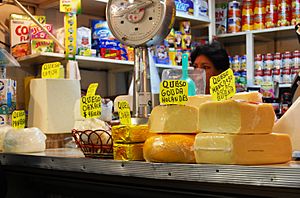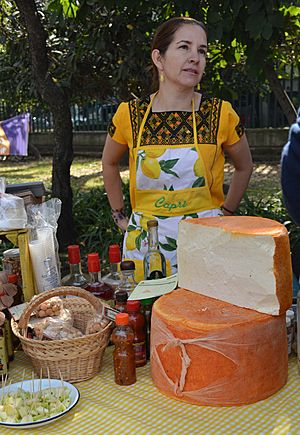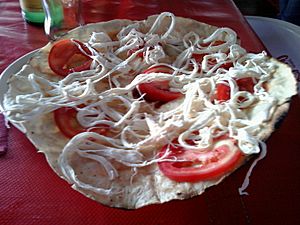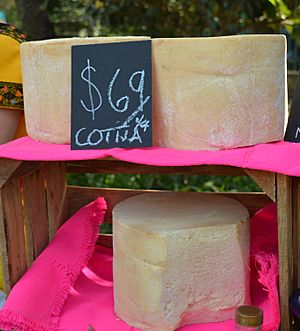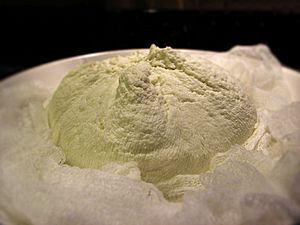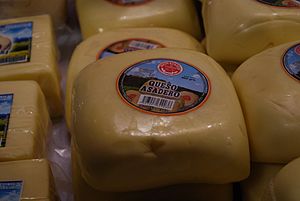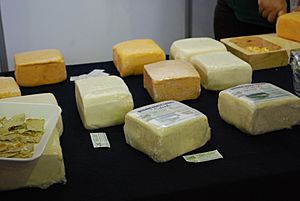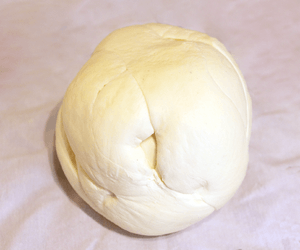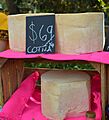Cheeses of Mexico facts for kids
Cheeses in Mexico have a rich history that started when the Spanish arrived. Before that, people in ancient Mesoamerica didn't know about dairy products. The Spanish brought animals like cows, sheep, and goats, along with ways to make cheese. Over time, cheesemaking in Mexico changed. It mixed European and local tastes, and different regions developed their own unique cheeses.
Today, Mexico has many kinds of cheeses. Most are made from cow's milk, but some use goat's milk. Recently, there's been more interest in cheeses made from sheep's milk. Many traditional Mexican cheeses are made with raw (unpasteurized) milk. You can find cheese made at home, on small farms, or by big companies. There are about 20 to 40 different types of Mexican cheeses. Some, like Oaxaca cheese and panela, are popular everywhere. Others are only known in certain parts of the country, and some rare ones are even in danger of disappearing.
Contents
How Mexican Cheeses Started
Before Europeans came, people in Mesoamerica didn't eat dairy products, so they didn't make cheese. The Spanish explorers brought cows, goats, and sheep to the New World. This completely changed what people ate. They also brought cheesemaking skills from Spain, like how to make manchego cheese.
Over time, as European and local cultures mixed, cheeses changed to fit new tastes. These changes happened differently in various regions. That's why Mexico has so many different kinds of cheeses today.
Cheesemaking has always been common, often done at home, since the time of the Spanish colonies. Some of the first places famous for cheese were the Altos de Jalisco and the Comarca Lagunera area in Coahuila and Durango. These areas are still big producers of cheese and other dairy products. Today, other important cheese-making regions include Chihuahua, Oaxaca, Querétaro, Aguascalientes, Guanajuato, San Luis Potosí, Michoacán, Puebla, Tlaxcala, Toluca, and Chiapas.
Even with centuries of experience, Mexico makes less cheese and fewer types than Europe. Most Mexican cheeses are made by small farms and businesses. They usually sell their products locally.
Some cheeses, like Chihuahua and panela, are now made in large factories using pasteurized milk. But most traditional cheeses are still made locally with raw milk. Mexican cheeses don't have standard rules for how they are made or their quality.
Mexican and Mexican-style cheeses are now easier to find in stores in the United States. In the past, only common ones like Cotija cheese (sprinkled on dishes) and Oaxaca cheese (melted on tortillas) were available. Now, companies in the U.S. are making many fresh and aged Mexican cheeses, even some of the less common types.
Making and Selling Cheese
Mexico is ranked 10th in the world for making cheese and 8th for eating it. Mexico, Argentina, and Brazil together are the third-largest cheese producers, after Europe and the U.S. In 2003, Mexico sold 218,000 tons of cheese. Fresh cheeses made up over one-third of this market. That year, Mexico produced only 126,200 tons of the cheese it ate, importing the rest. About 10% of the milk produced in Mexico is used to make dairy products, mostly cheese.
Most cheese in Mexico is made from cow's milk. While some cheeses use goat's milk, they are not as popular and can be harder to find. Raising sheep for milk hasn't been a big business in Mexico. However, since the 1980s, efforts to promote sheep's milk and meat have led to more sheep being raised. This helps develop sheep's milk cheese in Mexico, though it's still a small part of the market. Querétaro is a major sheep-producing state, and most of its sheep's milk goes into cheesemaking.
Most "fresh" cheeses are aged for only a few days. This isn't enough time to kill harmful bacteria that might be in raw (unpasteurized) milk. Using raw milk has caused some food-related illnesses linked to cheese, especially fresh, unaged types. Because of this, there are strict rules against bringing certain Mexican cheeses into the U.S. The cheeses that have caused the most problems are panela, asadero, queso blanco, and ranchero. These are not aged and are often made with unpasteurized milk.
In 2008, Mexico published a plan to improve safety rules for cheese. One main rule was to ban cheeses made with raw milk. However, some people argue that pasteurization isn't the only way to prevent illness. They also say that pasteurization kills good bacteria that affect the cheese's taste and health benefits. This is especially true for aged cheeses.
Mexico makes between 20 and 40 different types of cheeses. Some, like Chihuahua and Oaxaca, are made in large amounts. But most are regional, meaning they are only known in certain areas. Some of the rarest ones are in danger of disappearing. As of 2016, four cheeses have special protection for their names: Queso Cotija (from Michoacán, since 2005), Queso de Bola de Ocosingo (from Chiapas, since 2005), Queso de Poro de Balancán (from Tabasco, since 2012), and Queso Crema de Cuadro (from Chiapas, since 2013).
Cheese producers range from large factories that make common cheeses for supermarkets to small farms that handcraft cheeses. Some well-known big producers include Chilchota, Covadonga, and Grupo Lala. Mass-produced cheeses are usually sold in modern packaging. Their quality is often not as good as those made by smaller producers. Homemade cheese is still made in Mexico, sometimes called "bathtub cheese."
The National Wine and Cheese Festival, Feria Nacional del Queso y el Vino, happens every year in Tequisquiapan, Querétaro, from late May to early June. This festival celebrates the area's wine and cheese. It also invites producers from other parts of Mexico and the world.
In some traditional markets, like Coyoacán and San Juan in Mexico City, you can find handcrafted cheeses from small local farms. In Chihuahua, cheese is made from cows that are descendants of those brought by the Spanish. Cheesemaking is still a big part of the culture there. Most cheese is made at home or on ranches. Ranchers wake up early to milk cows and make queso ranchero, requesón, panela, and other cheeses. Local or handcrafted cheeses are sold at cheese stalls, often in baskets, wooden hoops, corn husks, or pressed into flat, white disks.
Some special cheese makers have even competed internationally. The Carlos Peraza family won a medal in France for their cheese. In Baja California’s wine region, a famous cheesemaking place is La Cava de Marcelo. It's named after Marcelo Castro Ramonetti, whose family came from Switzerland in 1911. He is a fourth-generation cheesemaker. His cheese cellar is 4 meters underground and stores 10,000 pieces of cheese. It provides cheeses to fancy restaurants and stores in Mexico. Some of their cheeses age for up to 2 years.
Most cheese made in Mexico is of local types. But some European styles like feta, Spanish manchego (from goat's milk), Saint Maure, and camembert are also made. The state of Guanajuato is known for making copies of European cheeses, especially French ones.
In Chiapas, researchers are studying a Spanish cheese called la Serena. They want to create a certified version of it in Mexico. This involves bringing in Merino sheep and learning how to make the cheese. Parts of Chiapas have a climate similar to the region in Spain where la Serena is made. Researchers have found they can make la Serena cheese and other types too. Even though sheep can produce milk for cheese, most sheep in Mexico are raised for wool and meat.
Types of Mexican Cheeses
It's hard to say exactly how many types of cheese are made in Mexico. Different regions might have different names for the same cheese, or the same name for different cheeses. Most popular types are fresh cheeses, like queso fresco, panela, and asadero. The two most popular aged cheeses are Cotija and Chihuahua.
Four cheeses that are truly Mexican inventions are Oaxaca, Cotija, and Chihuahua. The Mexican manchego cheese shares its name with a Spanish cheese, but it's made differently. The Spanish manchego uses sheep's milk, while the Mexican one uses cow's milk or a mix of cow's and goat's milk. The original Spanish manchego is also aged longer and has a stronger taste. Many Mexican cheeses are regional, but the common ones mentioned here are known across the country. Often, cheese is used as a topping or side, not as the main part of a dish.
The most basic Mexican cheese is queso fresco. Other cheeses like panela, adobera, and Oaxaca came from it. Queso fresco is made with whole milk but has low fat and cholesterol. It's a white, spongy cheese that came from Burgos, Spain. It's mostly used to crumble over dishes. This cheese is made almost everywhere in Mexico with little change.
In some parts of Mexico, queso asadero is a different cheese. It's white, semi-soft, and melts well. It's often used to make queso fundido (a melted cheese dish like fondue) or quesadillas.
Panela is another white, fresh-milk cheese with little fat or cholesterol. It likely came from the Balkans or Italy but has changed a lot to fit Mexican tastes. It's made with skim milk, giving it a firm texture and a sweet-sour taste. In traditional markets, it's often sold in baskets where it was shaped, which is why it's also called queso de canasta (basket cheese). It's often served cold as a snack or on sandwiches.
Queso blanco, also called queso sierra or queso enchilada, is a creamy, white cheese made from skimmed cow's milk. It's like a mix of mozzarella and cottage cheese. People often make it at home using lime juice to curdle the milk, which gives it a citrus flavor. When heated, it softens but doesn't melt.
Requesón is a loose cheese, similar to ricotta or cottage cheese, made with whole cow's milk. Traditionally, it's sold wrapped in fresh corn husks. It has a light, not salty taste. It's used for enchiladas, tostadas, cheese spreads, and more.
Chihuahua cheese is named after the Mexican state where a large Mennonite community created it. It's also called queso menonita. The original version is semi-hard with tiny holes, similar to a cheese called Chester. This version is sold wrapped in cloth and wax. Its taste can be sharp like Cheddar or mild. It's pale yellow, not white. Today, it's made all over Mexico and is popular as a factory-produced cheese.
Queso crema or doble crema (double cream cheese) is made with cow's milk and extra cream. It's spreadable and often used in desserts.
Mexican manchego cheese came from the La Mancha region in Spain. But it tastes quite different because in Mexico, it's made with a mix of cow's and goat's milk, not sheep's milk. It has a buttery taste and melts well. This cheese is available everywhere in Mexico and also in the United States. Usually, manchego is not aged. The aged version is called queso manchego viejo. This one is firmer and has a stronger flavor. It's often grated over dishes. In northern Mexico, especially in Chihuahua, this cheese can also be called asadero. As of 2018, Mexican manchego made up almost 15% of all cheese sales in Mexico.
While other places make commercial versions, Cotija cheese is originally made in Cotija, Tocumbo, and Los Reyes in Michoacán, and Quitupan, Santa María del Oro, and Jilotlán de los Dolores in Jalisco. These towns are in the Sierra de Jal-Mich region, which crosses both states. To be officially recognized as Cotija, the cheese must also be made with pasteurized milk for safety. This goat cheese was fully developed in Mexico. It tastes and feels similar to Italian parmesan. It has a light golden color and a strong sour-milk smell. It's aged for about 12 months. Sometimes, the cheese wheels are covered in chili paste to prevent mold. It's usually sprinkled on dishes for extra flavor, or used in pastas and salads. This cheese is also popular in the United States, where it's imported and made locally. However, U.S.-made Cotija is different from the Mexican one, as American producers add enzymes to make it age faster.
Queso añejo (meaning "aged cheese") is the aged version of queso fresco. It's called a soft cheese, but well-aged batches can become quite firm and salty. It's mainly used as a garnish. Queso añejo can also be found with a coating of chili pepper (called enchilado).
Oaxaca cheese started in the state of Oaxaca. Now, it's made and eaten almost everywhere in Mexico, but it's generally only found within Mexico. It's a soft, stretchy cheese made from cow's milk, much like asadero. The cheese's acidity is changed to make it stringy. Then, it's formed into ropes and wound into balls. This cheese melts well, especially for quesadillas. It's also often eaten pulled apart or shredded on top of dishes. Oaxaca cheese can be used instead of mozzarella in salads.
Queso de bola or queso Ocosingo is made only in Chiapas and is almost unknown outside that state. It's made with cow's milk with extra cream added. It has a strong flavor, a creamy, crumbly texture, and a light yellow color. It's prepared with a wax coating. After a long aging period, it forms a hard shell. This shell is often hollowed out and filled with meat, then cooked in banana leaves to make a dish called queso relleno (stuffed cheese). The hard shell of Ocosingo cheese is similar to that of Edam cheese.
Besides the cheeses mentioned, many regional cheeses are made in small amounts and are not well-known outside their local areas. Porta salud is an aged semi-hard cheese with a strong flavor and orange color. Queso jalapeño is a soft cow's milk cheese with bits of jalapeño chili pepper. It's served cold or melted in quesadillas. Queso criollo is a semi-firm, pale yellow cheese special to Taxco, Guerrero. Queso corazon is a very moist cream cheese from Chiapas. It gets its name because it was traditionally shaped like a heart, but most makers now mold it into a rectangle.
Queso Zacatecas is an aged cheese that is usually hard on the outside and a little soft inside. It's white with a hint of yellow. It crumbles and can't be sliced. Instead, it's served grated. Queso molido, also called queso prensado, is sometimes covered in a red chili pepper paste. Costena cheese is a specialty of Guerrero. It has a crumbly texture and tastes like fresh or slightly sour milk. It's usually white. "Queso Real del Castillo" is a semi-hard cheese made in the Ojos Negros and Guadalupe valleys east of Ensenada, Baja California.
A small area in Veracruz state around La Joya is known for its smoked cheeses. These are made with whole raw cow's milk and pressed after curdling. The cheese is often served with ham, chili peppers, epazote, and slices of jalapeños. Another type of Veracruz cheese, marqueta, is a white cheese often coated with chili pepper paste. The Yucatan area also makes a type of bola cheese. This version is harder all the way through and has small, uneven holes. Another type, queso de barra, is similar to panela.
Images for kids
See also
 In Spanish: Quesos de México para niños
In Spanish: Quesos de México para niños


